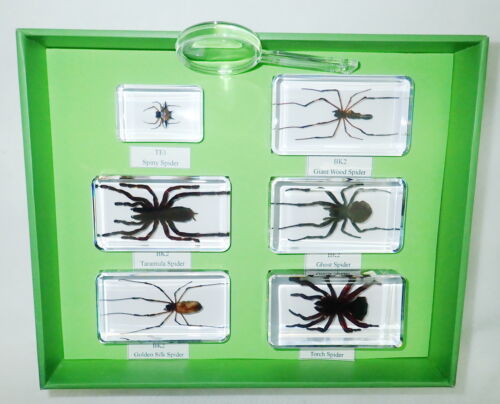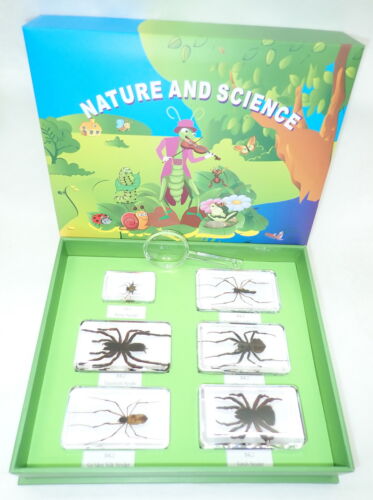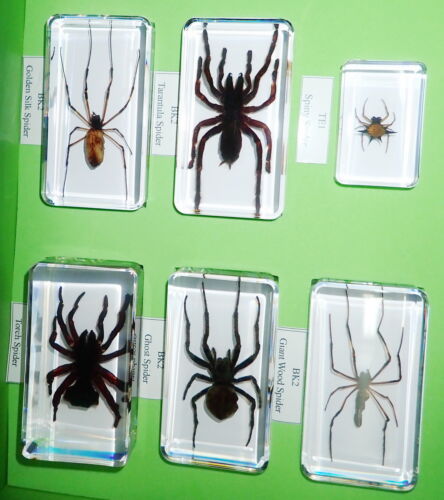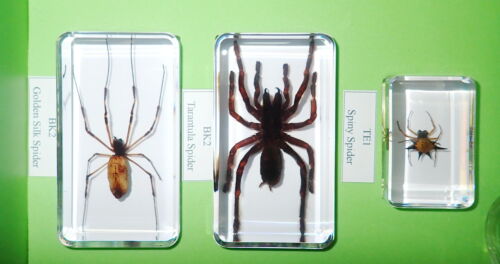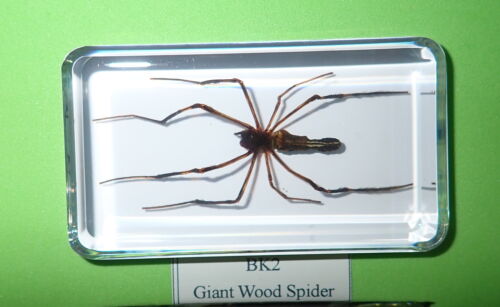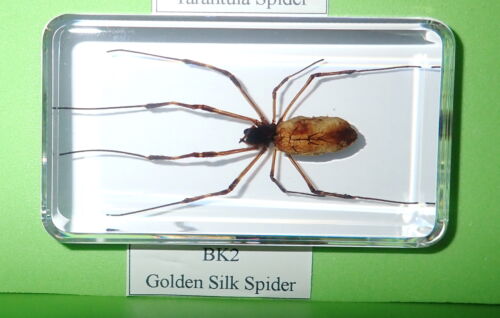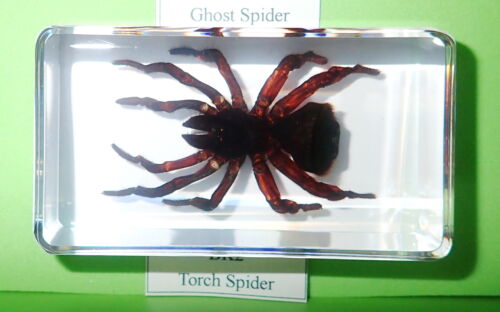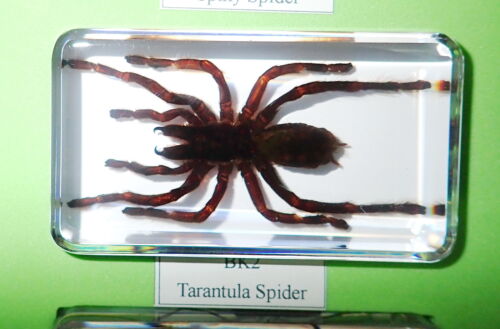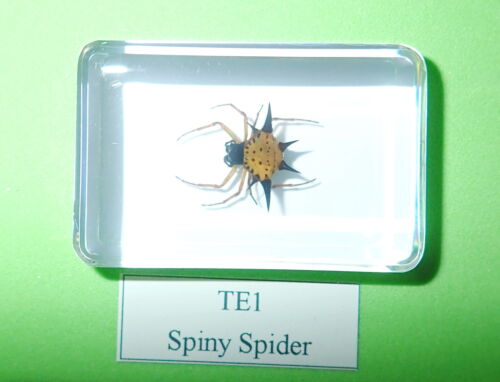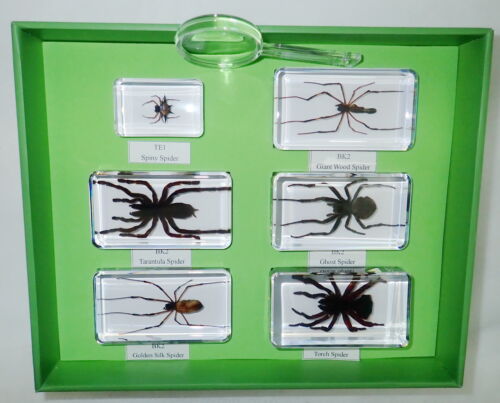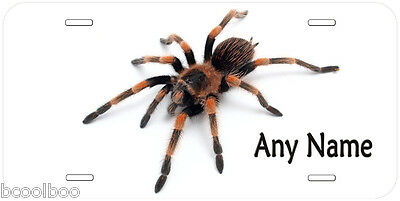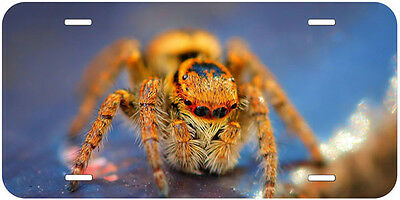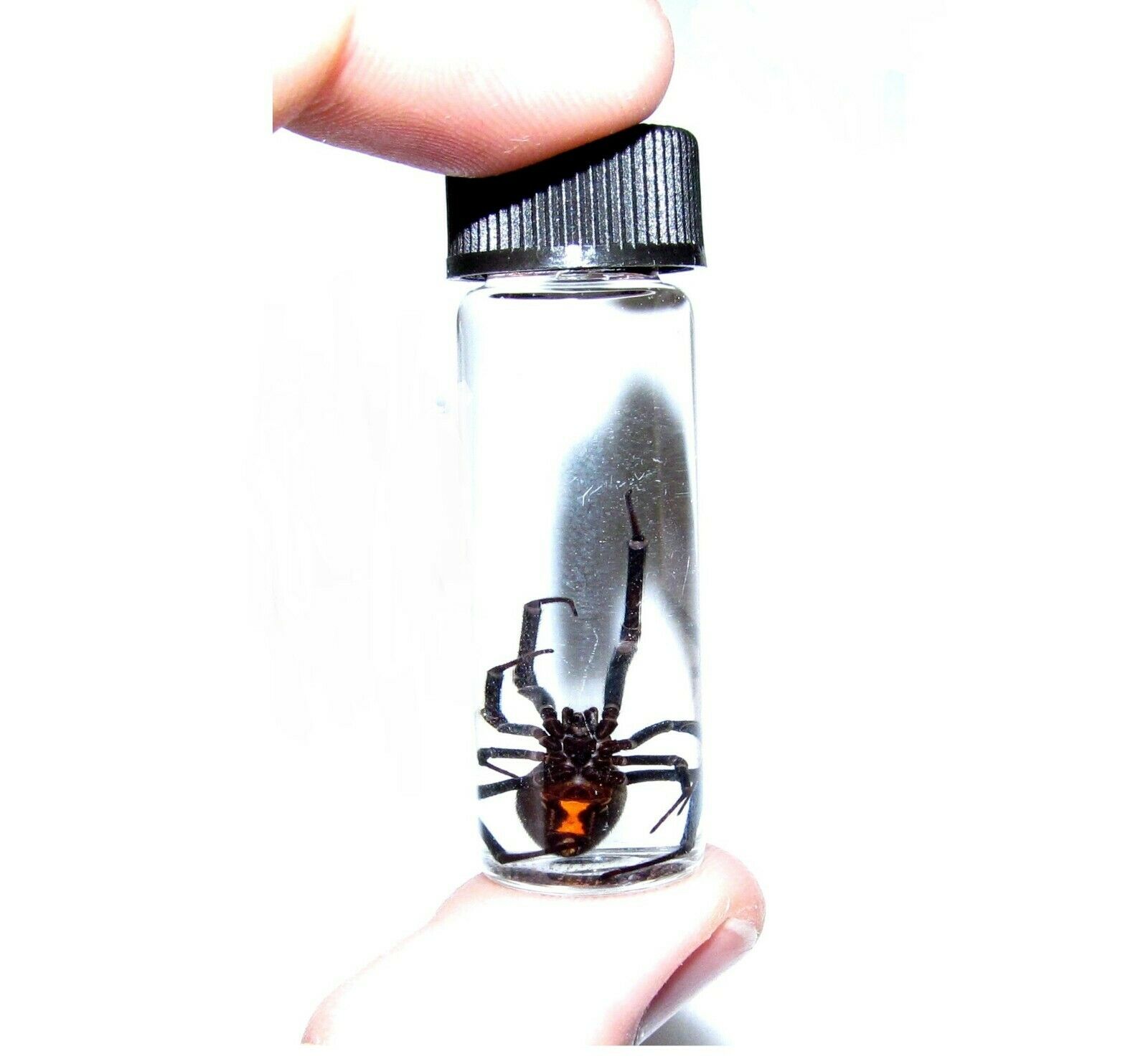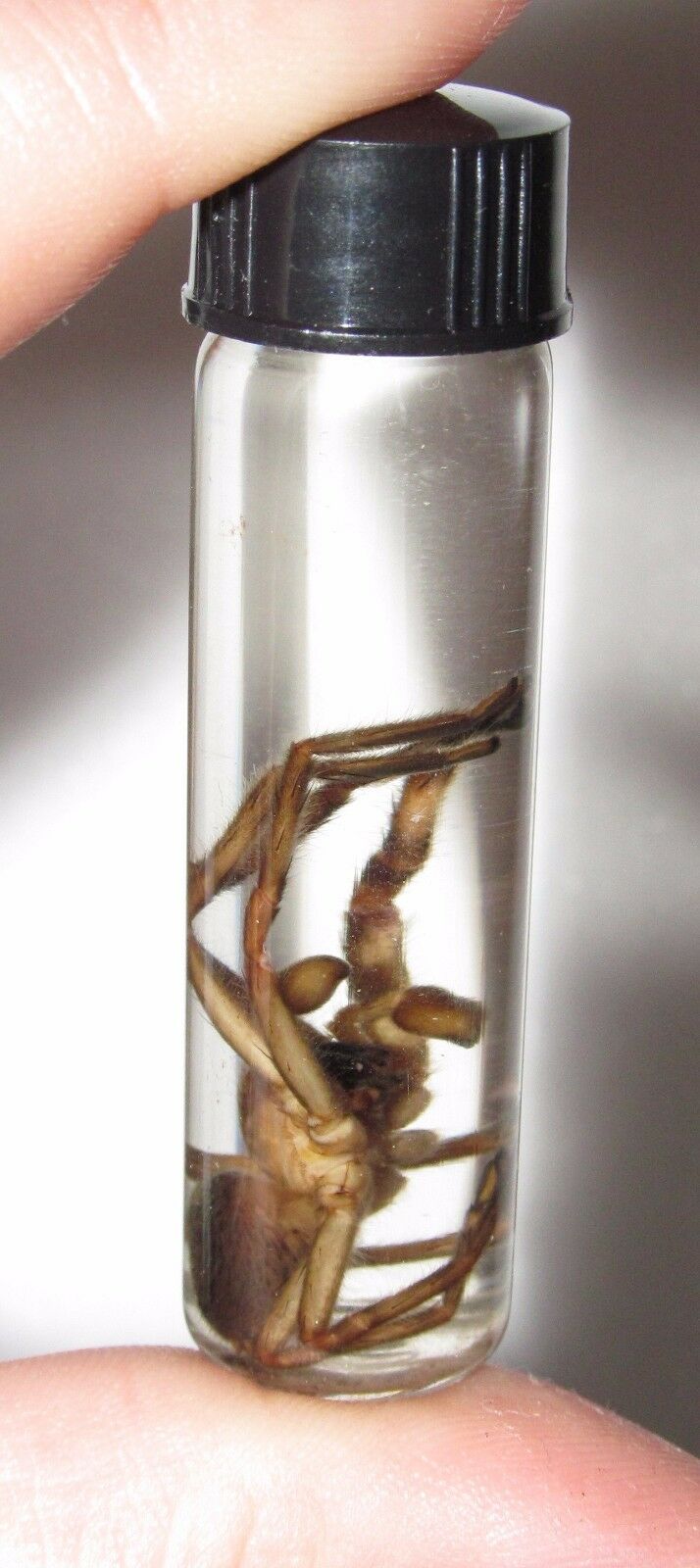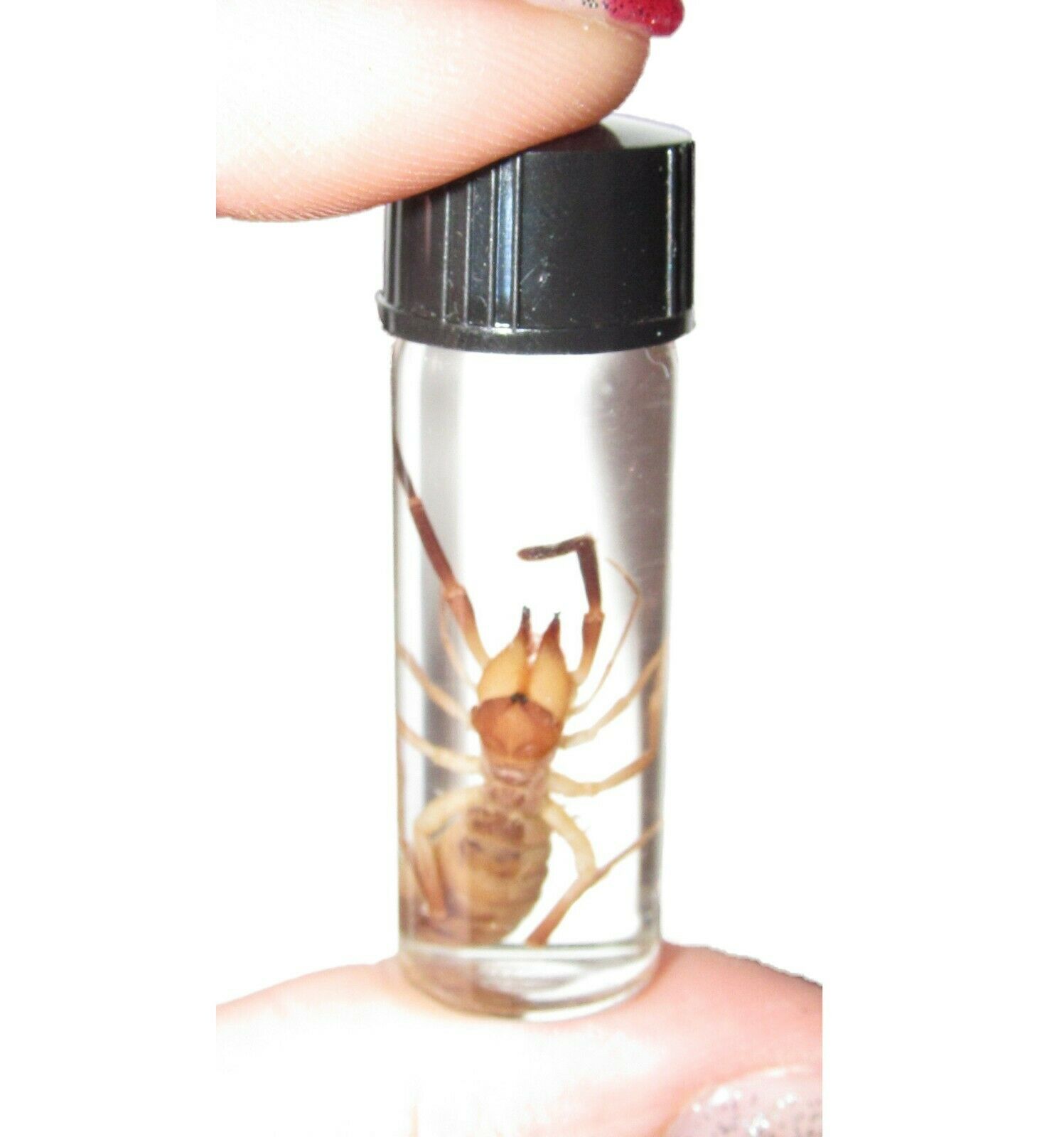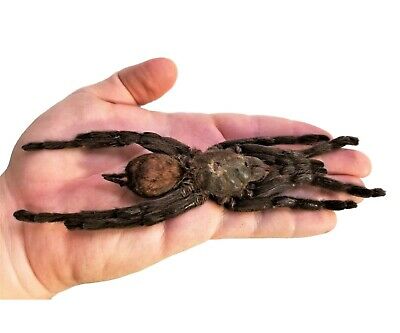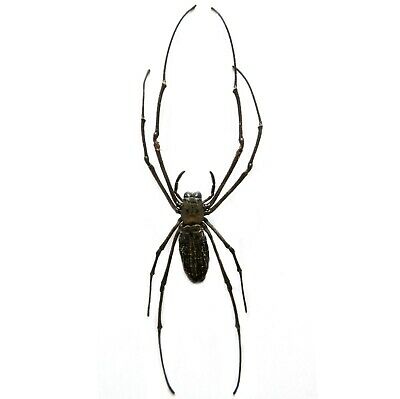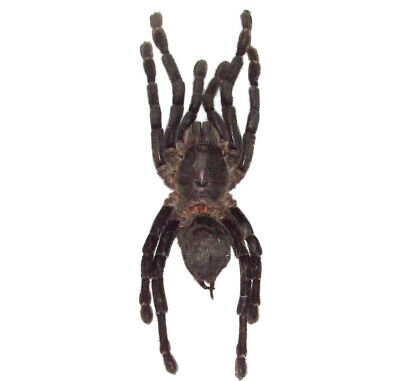-40%
6 Spider Specimen Collection Box Set TES6 6 blocks Real Insect Education Kit
$ 25.34
- Description
- Size Guide
Description
6 genuine different Spiders permanently encased in clear lucite material (in separate individual block). The specimens are crystal clear, indestructible and transparent. Safe, authentic and completely unbreakable product put living Spiders right at your fingertips!Anyone can safely explore the Spiders from every angle.
It is clear enough for microscope observation.
Each set has a magnifier for close-up observation.
Size of each block is 7.3x4.1x2.4 cm (2.9x1.6x0.9 inch) and 4.5x3.0x2.5 cm (1.8x1.2x1.0 inch)
Weight of each block is 120 g and 30 g.
Total weight of the whole set is 400 g and 600 g with packing box.
The Nature Garden
6 Spider Specimen Collection Box Set TES6 6 blocks Real Insect Education Kit
6 genuine different
Spiders
permanently encased in clear lucite material (in separate individual block). The specimens are crystal clear, indestructible and transparent. Safe, authentic and completely unbreakable product put living Spiders right at your fingertips!
Anyone can safely explore the Spiders from every angle.
It is clear enough for microscope observation.
Each set has a magnifier for close-up observation.
Size of each block is 7.3x4.1x2.4 cm (2.9x1.6x0.9 inch) and 4.5x3.0x2.5 cm (1.8x1.2x1.0 inch)
Weight of each block is 120 g and 30 g.
Total weight of the whole set is 400 g and 600 g with packing box.
This is a handmade real animal specimen craft.
Each one will be a bit different (specimen size, color and posture) even in the same production batch.
The pictures in the listing are just for reference as we are selling multiple pieces with same picture.
It is an ideal learning aid for students and kids and also a very good collectible item for every body.
*** These spiders are all from China.
1) Torch Spider 2) Ghost Spider 3) Giant Wood Spider
4) Spiny Spider 5) Tarantula Spider 6) Golden Silk Spider
***
Ghost Spider -
Araneus ventricosus
Female body length of up to 20 ~ 30 mm. Multi-stripe and color variations, usually black or dark brown, dust-color carapace, lateral fossa, radiation significantly ditch. Dun chest plate, the central vertical with a light. Pereiopod dust-color, with black round-shaped pattern. Oval abdomen, shoulders in front of each of a blunt cone protruding. Dust-color on the back, we can see clearly the central dark brown leaf-spot. Ventral wire in front of the warts have a pair of round yellow spots, and some of the former silk warts and another outside a pair of round yellow spots. Epigynum of long-tongued-shaped pituitary, the most wide-base gradually narrowed down, the blunt end of the round.
Male smaller size, length 15 ~ 20 mm. Light-colored, with zebra and female. Article II pereiopod medial tibia at the end of a Tuci, bend communis section.
Widespread at lower elevations around the mountains, fields and parks. In the evening, at the edge of the woods or under the eaves predator networks, network for the rotary. Often undermine the networks during the day, hiding in the branches next to the net or leaves the building in the pit.
Distribution
: China, Korea, Japan, Russia, Taiwan
Spiny Spider -
Gasteracantha sp.
Scientific name: Gasteracantha sp.
Family: Araneidae
Spiny spiders
(Gasteracantha sp.)
are only 4-10mm. in size but build strong vertical webs; live mainly in secondary forests.
This spider of the nature, can be presented in different colors, even so the species remains the same one. The males are very lesser, and the females biggest, being possess two reproductive agencies (one in each side of the body), can be found in only one of the sides, being virgin of the other side, or to be found in both. Behavior: In the spiders of the sorts Gasteracantha, Micratena and Eriophora the male constructs the “wire of on acasalamento” to the teia of the female. It touches this wire as if it was musical instrument of rope to excite the female sexually and to make to take it position receptive. While the female is magic with the cut, the male copula quickly and runs away before it perceives that she was copulada. Thus, the males of these spiders obtain to survive and to go to look other females to fecundar them. If they had been devorados, each male would die fecundando an only female, and with certainty leaving lesser number of descendants of what chance was had to cross more than with a sexual partner. It constructs to teias orbiculares, generally in the height next to 1,70 m of the ground, in vertical position in the sustentation structure, places bigger tuchos of teia, that according to researchers seems that it serves of alert the birds, or bigger insects, preventing as soon as the teia is destroyed in possible collisions. FOOD: small insects.
Tarantula Spider
Golden Earth Tiger Tarantula
--
Haplopelma schmidti
Order: Araneae Suborder: Mygalomorphae Family: Theraphosidae Subfamily:
Ornithoctoninae
Origin: North Vietnam, China
Way of life: living underground
Body length: about 8-9 cm
Haplopelma schmidti is highly variable in color. The most popular color has a brown base coloration with longer yellowish hairs. The Carapax is brown to golden-yellow in color. The abdomen is brown with a subscription model.
There are a whole range of other colors. Characteristic of all the color is a white "beard" of long hair on the outside.
It is often outside of the sub-slip to see, and submit long starvation period.
Originating in Vietnam, this natural wonder has golden legs and carapace with black femurs, white markings on sides of chelicerae, and a beautiful "tiger" pattern on abdomen. Reports of high potency of venom follows this spider, recommended caution with this beast of 8" aka Vietnam Chinese Giant Gold
The Golden Earth Spider is a fairly large specimen, with a typical legspan of up to 8" (20 cm). It thrives in the tropical rain forests of southern China and Vietnam, where it builds and lives in burrows up to several feet deep, emerging to capture food. The bird spider preys on numerous small insects and other creatures, such as cockroaches, crickets, and mice.
Golden Silk Spider
-
Argiope ocula
Order: Araneae Family: Araneidae Genus:
Argiope
The genus
Argiope
includes rather large and spectacular spiders that have often a strikingly coloured abdomen. These are well distributed throughout the world, and most countries in temperate or warmer climates have one or more species, which look similar.
The average orb web is practically invisible, and it is easy to blunder into one and end up covered with a sticky web. The very easily visible pattern of banded silk made by
Argiope
is pure white, and some species make an "X" form, or a zigzag type of web (often with a hollow centre). The spider then aligns one pair of its legs with each of the four lines in the hollow "X", making a complete "X" of white lines with a very eye-catching spider coloured bright yellow on a field of black or variegated red white and yellow stripes forming its centre. The white patterns are called stabilimentum and reflect UV light. They have been shown to play a role in attracting prey to the web, and possibly to prevent its destruction by large animals. The centres of their large webs are often just under 1 metre above the ground, so they are too low for anything much larger than a rabbit to walk under. The overtness of the spider and its web thus has been speculated to prevent larger creatures from accidentally destroying the web and possibly crushing the spider underfoot.
The male spider is much smaller than the female, and unassumingly marked. When it is time to mate, he spins a companion web alongside the female's. After mating, the female lays her eggs, placing her egg sac into the web. The sac contains between 400 and 1400 eggs. These eggs hatch in autumn, but the spiderlings overwinter in the sac and emerge during the spring. The egg sac is composed of multiple layers of silk and protects its contents from damage; however, many species of insects have been observed to parasitise the egg sacs.
Like almost all other spiders,
Argiope
are harmless to humans. Like most garden spiders they eat insects, and they are capable of consuming prey up to twice their size.
A. savigny
was even reported to occasionally feed on the small bat
Rhynchonycteris naso
.[2] They might bite if grabbed, but other than for defense they do not attack large animals. Their venom is not regarded as a serious medical problem for humans; indeed, they often contain a library of polyamine toxins with potential as therapeutic medicinal agents.
Giant Wood Spider -
Nephila maculata
Common names: Golden Orb Web Spider or Giant Wood Spider
Main features: Large (female only) shiny legs with red or yellow 'joints', builds large orb webs.
Female: 20cm across from toe to toe, with a body about 3-5cm; males are only one-tenth as big, at 5-6mm.
World distribution: Tropical areas from Africa, India, China, Japan across Southeast Asia to Northern Australia and the South Pacific islands.
Classification: Family Araneidae which build orb-webs. Nephila maculata is the largest of its genus.
The female buries her eggs in the ground. First she digs a shallow hole with her strong mandibles and legs, which is then lined with woolly silk. She lays her eggs on this silk, covers it with another woolly layer then covers the whole assembly with camouflaging debris and soil. Laying can take 4 hours. Spiderlings hatch with their eggyolks still attached and don't have fully developed mouthparts, venom glands, digestive tracts or spinning organs. They may stay together at this stage. When they are fully developed, they have to disperse or they will cannibalise each other.
Role in the habitat: Like other predators, the spiders control the population of prey. They are in turn preyed upon by other creatures such as birds. In New Guinea, some tribes consider them a tasty treat. The Golden Orb Web Spider's venom is generally harmless to humans and they rarely bite even if we blunder into and destroy their webs. The bite is just a scratch. They are clumsy on the ground.
Torch Spider -
Cyclocosmia ricketti
Order: Araneae Family: Ctenizidae Genus:
Cyclocosmia
Cyclocosmia
or "trapdoor spider" is a genus of spiders in the Ctenizidae family.
The abdomen of spiders in this genus is abruptly truncated and ends in a hardened disc which is strengthened by a system of ribs and grooves. They use this to clog the entrance of their 7 to 15 cm deep vertical burrows when threatened, a phenomenon called phragmosis. Strong spines are located around the edge of the disc. The four spinnerets are found just anterior to it, with the posterior, retractable spinnerets particularly large.
C. ricketti
females are 28 mm long, with a disc diameter of 16 mm. Only the bottom portion of the burrow is silk lined.
The individual species are separated from each other by the pattern of the abdominal disc, the number of hairs on its seam, and the shape of the spermathecae.
Item Specifics
Country/Region of Manufacture :
China
Material :
Resin
Type :
Collector Plate
Country of Manufacture :
China
Modified Item :
No
Handmade :
Yes
Payment
By Paypal
Shipping
Free shipping cost.
We send the goods to USA, Canada, UK, Australia, New Zealand, EU countries and some other European and Asian countries by E-express, a kind of fast postal service by Hong Kong Post. It usually takes about 6 to 10 working days for delivery.
We send the goods to other countries by registered airmail and will take about 8 to 14 working days for delivery.
Returns
Returns: We accept returns with any reason in 30 days.
Contact Us
We will answer buyer messages within 24 hours during working days.
The Nature Garden
From all around the world
DESCRIPTION
PAYMENT
SHIPPING
RETURN POLICY
CONTACT US
6 Spider Specimen Collection Box Set TES6 6 blocks Real Insect Education Kit
6 genuine different
Spiders
permanently encased in clear lucite material (in separate individual block). The specimens are crystal clear, indestructible and transparent. Safe, authentic and completely unbreakable product put living Spiders right at your fingertips!
Anyone can safely explore the Spiders from every angle.
It is clear enough for microscope observation.
Each set has a magnifier for close-up observation.
Size of each block is 7.3x4.1x2.4 cm (2.9x1.6x0.9 inch) and 4.5x3.0x2.5 cm (1.8x1.2x1.0 inch)
Weight of each block is 120 g and 30 g.
Total weight of the whole set is 400 g and 600 g with packing box.
This is a handmade real animal specimen craft.
Each one will be a bit different (specimen size, color and posture) even in the same production batch.
The pictures in the listing are just for reference as we are selling multiple pieces with same picture.
It is an ideal learning aid for students and kids and also a very good collectible item for every body.
*** These spiders are all from China.
1) Torch Spider 2) Ghost Spider 3) Giant Wood Spider
4) Spiny Spider 5) Tarantula Spider 6) Golden Silk Spider
***
Ghost Spider -
Araneus ventricosus
Female body length of up to 20 ~ 30 mm. Multi-stripe and color variations, usually black or dark brown, dust-color carapace, lateral fossa, radiation significantly ditch. Dun chest plate, the central vertical with a light. Pereiopod dust-color, with black round-shaped pattern. Oval abdomen, shoulders in front of each of a blunt cone protruding. Dust-color on the back, we can see clearly the central dark brown leaf-spot. Ventral wire in front of the warts have a pair of round yellow spots, and some of the former silk warts and another outside a pair of round yellow spots. Epigynum of long-tongued-shaped pituitary, the most wide-base gradually narrowed down, the blunt end of the round.
Male smaller size, length 15 ~ 20 mm. Light-colored, with zebra and female. Article II pereiopod medial tibia at the end of a Tuci, bend communis section.
Widespread at lower elevations around the mountains, fields and parks. In the evening, at the edge of the woods or under the eaves predator networks, network for the rotary. Often undermine the networks during the day, hiding in the branches next to the net or leaves the building in the pit.
Distribution
: China, Korea, Japan, Russia, Taiwan
Spiny Spider -
Gasteracantha sp.
Scientific name: Gasteracantha sp.
Family: Araneidae
Spiny spiders
(Gasteracantha sp.)
are only 4-10mm. in size but build strong vertical webs; live mainly in secondary forests.
This spider of the nature, can be presented in different colors, even so the species remains the same one. The males are very lesser, and the females biggest, being possess two reproductive agencies (one in each side of the body), can be found in only one of the sides, being virgin of the other side, or to be found in both. Behavior: In the spiders of the sorts Gasteracantha, Micratena and Eriophora the male constructs the “wire of on acasalamento” to the teia of the female. It touches this wire as if it was musical instrument of rope to excite the female sexually and to make to take it position receptive. While the female is magic with the cut, the male copula quickly and runs away before it perceives that she was copulada. Thus, the males of these spiders obtain to survive and to go to look other females to fecundar them. If they had been devorados, each male would die fecundando an only female, and with certainty leaving lesser number of descendants of what chance was had to cross more than with a sexual partner. It constructs to teias orbiculares, generally in the height next to 1,70 m of the ground, in vertical position in the sustentation structure, places bigger tuchos of teia, that according to researchers seems that it serves of alert the birds, or bigger insects, preventing as soon as the teia is destroyed in possible collisions. FOOD: small insects.
Tarantula Spider
Golden Earth Tiger Tarantula
--
Haplopelma schmidti
Order: Araneae Suborder: Mygalomorphae Family: Theraphosidae Subfamily:
Ornithoctoninae
Origin: North Vietnam, China
Way of life: living underground
Body length: about 8-9 cm
Haplopelma schmidti is highly variable in color. The most popular color has a brown base coloration with longer yellowish hairs. The Carapax is brown to golden-yellow in color. The abdomen is brown with a subscription model.
There are a whole range of other colors. Characteristic of all the color is a white "beard" of long hair on the outside.
It is often outside of the sub-slip to see, and submit long starvation period.
Originating in Vietnam, this natural wonder has golden legs and carapace with black femurs, white markings on sides of chelicerae, and a beautiful "tiger" pattern on abdomen. Reports of high potency of venom follows this spider, recommended caution with this beast of 8" aka Vietnam Chinese Giant Gold
The Golden Earth Spider is a fairly large specimen, with a typical legspan of up to 8" (20 cm). It thrives in the tropical rain forests of southern China and Vietnam, where it builds and lives in burrows up to several feet deep, emerging to capture food. The bird spider preys on numerous small insects and other creatures, such as cockroaches, crickets, and mice.
Golden Silk Spider
-
Argiope ocula
Order: Araneae Family: Araneidae Genus:
Argiope
The genus
Argiope
includes rather large and spectacular spiders that have often a strikingly coloured abdomen. These are well distributed throughout the world, and most countries in temperate or warmer climates have one or more species, which look similar.
The average orb web is practically invisible, and it is easy to blunder into one and end up covered with a sticky web. The very easily visible pattern of banded silk made by
Argiope
is pure white, and some species make an "X" form, or a zigzag type of web (often with a hollow centre). The spider then aligns one pair of its legs with each of the four lines in the hollow "X", making a complete "X" of white lines with a very eye-catching spider coloured bright yellow on a field of black or variegated red white and yellow stripes forming its centre. The white patterns are called stabilimentum and reflect UV light. They have been shown to play a role in attracting prey to the web, and possibly to prevent its destruction by large animals. The centres of their large webs are often just under 1 metre above the ground, so they are too low for anything much larger than a rabbit to walk under. The overtness of the spider and its web thus has been speculated to prevent larger creatures from accidentally destroying the web and possibly crushing the spider underfoot.
The male spider is much smaller than the female, and unassumingly marked. When it is time to mate, he spins a companion web alongside the female's. After mating, the female lays her eggs, placing her egg sac into the web. The sac contains between 400 and 1400 eggs. These eggs hatch in autumn, but the spiderlings overwinter in the sac and emerge during the spring. The egg sac is composed of multiple layers of silk and protects its contents from damage; however, many species of insects have been observed to parasitise the egg sacs.
Like almost all other spiders,
Argiope
are harmless to humans. Like most garden spiders they eat insects, and they are capable of consuming prey up to twice their size.
A. savigny
was even reported to occasionally feed on the small bat
Rhynchonycteris naso
.[2] They might bite if grabbed, but other than for defense they do not attack large animals. Their venom is not regarded as a serious medical problem for humans; indeed, they often contain a library of polyamine toxins with potential as therapeutic medicinal agents.
Giant Wood Spider -
Nephila maculata
Common names: Golden Orb Web Spider or Giant Wood Spider
Main features: Large (female only) shiny legs with red or yellow 'joints', builds large orb webs.
Female: 20cm across from toe to toe, with a body about 3-5cm; males are only one-tenth as big, at 5-6mm.
World distribution: Tropical areas from Africa, India, China, Japan across Southeast Asia to Northern Australia and the South Pacific islands.
Classification: Family Araneidae which build orb-webs. Nephila maculata is the largest of its genus.
The female buries her eggs in the ground. First she digs a shallow hole with her strong mandibles and legs, which is then lined with woolly silk. She lays her eggs on this silk, covers it with another woolly layer then covers the whole assembly with camouflaging debris and soil. Laying can take 4 hours. Spiderlings hatch with their eggyolks still attached and don't have fully developed mouthparts, venom glands, digestive tracts or spinning organs. They may stay together at this stage. When they are fully developed, they have to disperse or they will cannibalise each other.
Role in the habitat: Like other predators, the spiders control the population of prey. They are in turn preyed upon by other creatures such as birds. In New Guinea, some tribes consider them a tasty treat. The Golden Orb Web Spider's venom is generally harmless to humans and they rarely bite even if we blunder into and destroy their webs. The bite is just a scratch. They are clumsy on the ground.
Torch Spider -
Cyclocosmia ricketti
Order: Araneae Family: Ctenizidae Genus:
Cyclocosmia
Cyclocosmia
or "trapdoor spider" is a genus of spiders in the Ctenizidae family.
The abdomen of spiders in this genus is abruptly truncated and ends in a hardened disc which is strengthened by a system of ribs and grooves. They use this to clog the entrance of their 7 to 15 cm deep vertical burrows when threatened, a phenomenon called phragmosis. Strong spines are located around the edge of the disc. The four spinnerets are found just anterior to it, with the posterior, retractable spinnerets particularly large.
C. ricketti
females are 28 mm long, with a disc diameter of 16 mm. Only the bottom portion of the burrow is silk lined.
The individual species are separated from each other by the pattern of the abdominal disc, the number of hairs on its seam, and the shape of the spermathecae.
Item Specifics
Country/Region of Manufacture :
China
Material :
Resin
Type :
Collector Plate
Country of Manufacture :
China
Modified Item :
No
Handmade :
Yes
Payment
By Paypal
Shipping
Free shipping cost.
We send the goods to USA, Canada, UK, Australia, New Zealand, EU countries and some other European and Asian countries by E-express, a kind of fast postal service by Hong Kong Post. It usually takes about 6 to 10 working days for delivery.
We send the goods to other countries by registered airmail and will take about 8 to 14 working days for delivery.
Returns
Returns: We accept returns with any reason in 30 days.
Contact Us
We will answer buyer messages within 24 hours during working days.
All right reserved.
Shop Category
Store Home
Fossils
◈ Insects
◈ Plants
◈ Trilobite
◈ Sea animals
Tektite
◈ Loose lots
◈ Single stone
Lapis Lazuli
▷ Polished stones
♢ Loose lots
♢ Single stones
▷ Rough stones
♢ Loose lots
♢ Single stone
◈ Craft items
Turquoise
◈ Natural turquoise
◈ Turquoise substitutes
Stone carving
Rough Stone & mineral
◈ Single piece
◈ Loose lots
Polished Stone & mineral
◈ Single piece
◈ Loose lots
Rough ruby & sapphire
◈ Ruby
◈ Sapphire
Star Ruby & Sapphire
◈ Star Ruby - Opaque
◈ Star Ruby - Transparent
◈ Blue Star Sapphire
◈ Star Sapphire - other colors
Animal specimen items
◈ Single specimen
◈ Life cycle
◈ Collection set
◈ Key ring
◈ Bracelet or bangle
◈ Necklace or pendant
◈ Magnet
◈ Ring
◈ Hanger
◈ Cabochon
◈ Sphere, ball
◈ Laminated specimen
◈ Computer mouse
◈ Stapler
◈ Pen
◈ Bottle Opener
◈ Dome paperweight
◈ Earring
◈ Skeleton
◈ Fish
◈ Butterfly
Plant specimen
◈ Flower
◈ Leaf
◈ Life Cycle
◈ Collection Set
◈ Laminated items
◈ Seed or root
Stone, mineral, fossil box set
Paper Cuts
Jewelry crafts
Other
Hot Item
10 Mohs Scale Stone Set clear plastic box Learning Real Specimen Kit
USD 16.00
Black Indochinite Tektite Stone 10 pieces Plastic Box Set Natural Specimen Kit
USD 14.00
Bat Skeleton GREATER BAMBOO BAT in Clear Block Education Real Animal Specimen
USD 16.00
Chinese Water Snake Skeleton in 110x45x18 mm Block Education Animal Specimen
USD 20.00
Fine Ground Cinnabar Crystal Tiny pieces 40 gram Lot
USD 18.00
Picture
New List Item
Turquoise Double-sided & Holed Free Cabochon 117 Carat 2 pieces 23.4 gram
USD 19.99
Large Fossil Raw Stone Petrified Wood 564 gram 88x82x58 mm
USD 39.99
Nice Natural Jadeite Rough Stone Slab 67.4 gram 108x28x10 mm piece
USD 11.99
Large Spodumene Kunzite Hiddenite Triphane Crystal 389 Carat 60x43x19 mm
USD 24.99
Gobi Desert Rose Crystal Cluster Raw Stone 352 gram 115x88x68 mm
USD 20.99
Custom Item
Powered by SoldEazy
